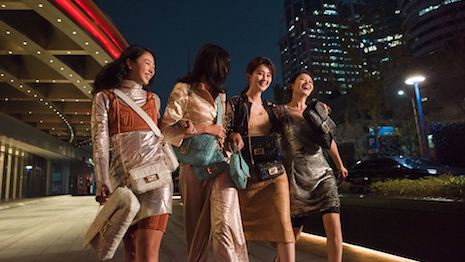Through 2019, the luxury market is projected to grow 4 percent at constant exchange rates to 1.3 trillion euros, or about $1.4 trillion, with all of the growth driven by Asian consumers and younger generations.
According to the 2019 edition of the Bain & Company Luxury Study, Asia and particularly China will see growth this year, while other regions will be flat or decline. One of the key trends that emerged this year was spending at home, with global spend by local consumers rising 11 percent while tourist expenditures rose 3 percent, benefitting markets that are nearby destinations for Chinese consumers.
"The global luxury market confirmed this year the moderate growth rate associated with the 'new normal' era, mainly driven by Asian buyers," said Claudia D'Arpizio, partner at Bain & Company and lead author of the study.
"The luxury customer is present and increasingly active, dramatically rewriting the rulebook of the industry," she said. "Brands will need to pivot to a new model to respond to customers' needs when it comes to buying, consuming and communicating."
Asia acceleration
In the last decade, the growth rates for luxury experiences surged ahead of the growth of luxury goods. However, Bain finds that more recently, experiential and tangible luxury categories are performing more similarly, as experience categories see slowed growth.
For instance, hotels saw more muted growth this year of 2 percent. However, luxury cruises were up 9 percent and sales of private jets and yachts rose 5 percent.
Luxury cars represent the largest subcategory studied in the research, totaling 550 billion euros this year. Automotive sales are also up 7 percent year-over-year, exceeding the overall growth across luxury sectors.
With sales totaling 281 billion euros, personal luxury goods are the second biggest sector. This category is up 4 percent this year.
Almost all categories studied saw growth, with the art market the only exception. Art sales declined 18 percent from 2018, which Bain attributes to a lower supply in the market.
Regionally, Mainland China saw the strongest growth, with sales rising 26 percent. Part of what drove growth in China was Chinese consumers spending at home, as they shied away from traveling to Hong Kong and international destinations.

Mandarin Oriental Landmark Hong Kong. Image credit: Mandarin Oriental
Japan and the rest of Asia also saw growth, up 4 and 6 percent respectively, thanks to tourist traffic from China.
Amid political unrest in Hong Kong, personal luxury good sales are down 20 percent from 2018. Despite an estimated 40 percent decline in tourist visits and a decrease in foot traffic between 30 and 40 percent, Bain notes that luxury store counts are remaining stable, with approximately 1,000 monobrand boutiques.
The Americas and Europe were mostly flat at constant exchange rates, as issues including the U.S.-China trade war and the yellow vest protests in France weighed on sales. The Middle East is down by about 5 percent from 2018 as consumers show less confidence.
Looking ahead, Bain projects that the luxury market will rise at a constant annual growth rate between 3 and 5 percent through 2025, reflecting the “new normal” of moderate growth.
Next generation
Luxury brands need to be focused on the next generations of consumers. In 2019, millennials are 35 percent of the personal luxury goods market and Gen Zers represent 4 percent of luxury sales.
By 2025, millennials will be 45 percent of the market, while Gen Z will be 10 percent. A decade later in 2035, millennials will remain stable at 45 percent while Gen Z will increase their spending to comprise up to 40 percent of the market.
Despite a reputation of being entitled and self-absorbed, a recent survey from Agility Research found high-spending Chinese Gen Zers to be self-aware with a special appreciation for luxury (see story).
"Gen Z customers are the new frontiers of tomorrow's luxury market – and they already represent a growing portion of luxury consumption in Asian markets," said Federica Levato, partner at Bain & Company and co-author of the study. "They see themselves as critical actors of the creativity and conversations with luxury brands; they are returning to products, stores and physical interactions with brands to truly connect and engage emotionally with them."
Younger consumers are helping to drive changes in luxury consumption and attitudes.
These generations are heavily fixated on sustainability. Led by millennials, 80 percent of luxury consumers say they prefer brands that are social responsible.
Luxury is also becoming more digital. Only 12 percent of luxury sales happen online, but ecommerce is up 22 percent from last year, driven mostly by accessories and beauty.
Monobrand stores are performing better than department stores. Brand-operated boutiques are up 12 percent, while department store sales are down 5 percent, attributed mostly to challenges among U.S. multi-brand retailers.
Airport retail and off-price are both up 11 percent.
Aside from shifting channels, luxury brands have to contend with emerging players, such as indie brands and new business models including rentals that challenge traditional retail.
Luxury brands have an opportunity to own more of the circular economy either through partnerships or directly operated services, as consumers open up to secondhand goods and alternative ownership.
During LuxeCX/AMCX 2019, two executives from Altiant shared research that shows that luxury brands’ stores and Web sites would be consumers’ preferred channel for rentals if they offered such a service. Additionally, three quarters of shoppers show an interest in being able to sell products back to luxury brands, pointing to further potential for luxury brands in the circular economy (see story).
"We see the secondhand market as a potential avenue for luxury brands to reach a new audience and enlarge their customer base," Ms. Levato said. "For many customers, this may be their first luxury purchase, but luxury brands shouldn't see this as a threat and should manage it strategically to grasp the full potential of this opportunity."
{"ct":"55ey+nJytbCVR8iudHG0AtbXdqciCsdz+K5xvo069xCyCcUZPUGYhvJHiqd9mgkep7o+DBQNgNyosa6p2iuz2TtZF\/0JtKXX8s+hlfIbUJI8RwccvjWBFSGsQkCRsp\/x+SrUBZa3PLjXdydoJIaa+sa351hP547RVknWzMq+4XlaYLIAdOemayxXwumv6DpsSNox2jojl8X16+5wZKbxnjndBQyhRK5b5n57byRSZbjdAEJvxG\/Ao6T4urk1R3d6zYTO\/bncJCPj4DbjRorzf7ceYuF2u7HjIbqogS2rbui3Iaqd06eodYs0s1+pPArSnGIgDfz+SmtBi4Vm0e1eXj01m15qFGTzXjNsWUmgJretzi7\/8A\/T++w084snvdqAgtOEqZVd00jcIEbXVmniT+pk1lnZ2sEasR2jPbz0572uFBYYgJt5UUE6KgUA067VTKLlfZGRie6Pf8g60R1xsaNMngU9laQnYULNU1L76dCq\/7HjLzMX1BlVRkyCQNhe5mR6ZcfP7VsaA8Jcb8OTPtgcf3RrUylMKBI4GQVORLxk62f9034QoADLvldphXJXEtkoUZFHORJvIfREScdoHhXoja5ilz7Zj7K9UzYORDACbsp1WfZvj89ePK2V68cLbEeb3\/VEpm1AkoeQ86WFhNKum3Zo0KkZ0Hk53\/gcrJ8JKOrz6je49GMt3wOOYt2PPz4ZyAWeM2rTuH5YItIiZlUj3Szb+Idn0qPXrDr5ITekYypF2CtKr5Y6HD5YXhv4zUFbGO6eVDIKoj+guZfygBdkSoy06Z8g1IujSUFN6JIOT7qNBvDNr9bheoSWnnDbtku65ztDjWfoaSZBgk2vvcFKOehyo60ZuuPBSDWyHy93aXVZFhj5LaKFGGyvRMcsTkMvGOVzta\/j3SMVogaXbQQDYw+rc0RaCN0WC72vHZfqpmCEyVO6vxUpN\/NitFbo4uchLpv3uGtYNlXXHmcWz5A2cSM55HOgD3oSktGzsA7+S0dTnSCmnlDC4ADxE\/bLgVhCTgyMHFjkFtGfsQYEVSLbWKhT9wr+rBv0eaDxtyrrQjOo7hUrOCcaZ5Bwa7BYI\/rOYFqbBrORXgZ2ltSH4LuGkeYB\/Who1pVr0oshbJ2xUAGeTwyij4F43sKJgmNl4coCP2hf1bQO7yoJ7ohUJONur7O9jSynwKmKhab4xXgEl\/iOOROG+75fmIqRHH77NvRBQYLU5MPtv4pKAsFgDTxOdPc3YOEGooYI\/Az2IinbSZZmALalOqL7I1OuLqAe3kPFmNNUr2pcLsYdPTOiCRT3BgVSHAHOP3ZstltxCfjKBEHbllek9ZqX8qVUQfYB1dpq44HWq+K\/F65E0ENI2mkVphbUpl93mrBYnw0LhrtcoNanFiIzJyBEwHLOjzLUo0EC6oK7nunJ+\/PYcjqnFlj7Ar5G5om0NbYqbA\/nA1DrjrkfGyz\/D7xYkKWWOuRhD\/2eVZLN9fWXNznFV4vRoSEwvAGUWvBn66inn9frFJF\/opW5Jwm5u5sRyjDjzaC3MhuCmJMYQQ0aHBA\/ZN6hJgJJKDbO9kwNz7GlHTzdDXt9nyixXwbRSLqt7osbibTYAG11wsRHL1kV\/Q8OyjkMcVwY3J73d\/0r7rXEaN1uub0cSIVK8mE0+83Dm4bfE9JJYKC0UDS6fymUnC6imO3vhequ0OHZ3wxfnxPr7JG49TrkbegPKWBkn5Vrt3m4Ozt0gLc8bPeKl+R6Bc\/rIwifAlis0tkTiX05AS1eJjBkHXHyp2rWU88Ilsyik6kRZ9JTkBjSpJ12pEQFm2ab8m3Keq6ebIQVYOc8cUuts576r3MzzxQ4H1+\/rk2DHCUCSyIugGi2QzgEreFQDv\/ZgiC9Ki4TD3BbUSG9FWxLK31HqcDIdtQ8d4EHtPSv9lQ7t0NJg6gHG85\/nKqfSuccU1OGWm1SNgpjfuEKUGdM759a9IFmulMSitmLssa2FIQhb0wQ9997HENU62d8ph0RwYXvcuDfVZh3pLYT4lIEKkqFiNX4bBEk3sIvz7wvHPXEAWBSBE8eHi6gftgmC6P3fNbgU5DkJYLspt3d+boQTrPi4WS0+eNoC9FDIWqn7pVqvRtlWTY2d70mVHxKx06C\/dRgzQmF98N78I\/BZYP\/ggkvY2X3dwaGf2Mz6f9dS6a4Ri6o0U+QYm2ZheLY0IkyE1Sq\/cx0evLmpHX9P7fxdDJV9nW9cgYiu3\/GaSFdASV2is18QQFLbeEpTUbgMu6+GVKwlrX929a7TU+doj+IPj\/CsPd53FnLNE2VTgxL7JqrSrmxxfAsEum81cjbjA\/tbBNgD31i6sA2JxF\/PbgxeVQRbkPw8i3dU9oSBd0IgUZPXVjKTgHCAQyVTZwbJZHgiqkqtfKwrqrpW\/IncYuXIpBnEDnZzVCZVWiufJaJjbAKE8x0QegDNgsMH\/hSwm+L8\/Uqb\/VmP4l39HEa6vcemdV\/bAaddDLS1XvWlQjRaRRXIeP9sri3RkZE+ULY16nVD8viiHb\/E\/anA6dKdKD+ROt7UhIOKJjQwEO+esRA28U91vNuEyDiCjVIekSUXFl8eHqbLAd+T6tlMLdhUfN4N7SbqvkEFrVJToSn1CZrzes+3Jz3eRhdPz9xfzk6OiZIQacddIIwPX5Ruv5yHa4f46oL5JCQRNY3ghkJ9RCzieTNJMecvY\/kj4KPFOe8hGG7r4\/NQo+qFym4nSy6IaWsc39r6I9PyVGnrFfLHLlsUqeYEMOuAmCLF6x0MVQknLhBSYwfx7rbzjB94mYpMRkHvM4FP8DND7yGleScWCxW\/b0QzftCL0tUDUvZMPoVdyk3v\/hFECs3i+4R0KLMm5NcQZMyTRLqQKR8RSev7l4w81rU8RrtSvDThks9djYvg8mt84iPYRhgmOnxMZLXkKPqqgroyI1BuQHfjqBmB361bqMJs60fJgictzR+8QDCE3OCmo9Yneficm6u1U4okGN0vq2TzVDj5ArGoA8bxcBe46fAddTL0vQ3clMu3mf147uR9joSgtfRTRLERVCGRrD7PtCrFjqSwXXT66jjmvjcZDXVnFVr7iLYxkcrngzB1shkZPuLEQ6tctfdh8z5LeuzKMnLq7+smZPOIosUO0C+1gV8mxR64XuVDXPkxmh89nFwBrwTxr2tI2ed\/vhvPCCodGcxpVq0Jvl+NJF0f69YHEY30+DnPCDUeoKJXnOkf7sG9bTiq7EW0iPCLD8ZipqZCw3\/IBJe1lXSHF2z70nU\/qi3C5X4z6kBod+PduhXXJYU8biTYfWsAeS6+bluIiVPQnTOaOW3mwnQa7lPIPIjrBMYhcFKu+NukH\/XLU57QtT3oQws3NueF5fGczY58S9EtvH1PZmGMAa6lhEI0L5FBZD3U9hRK3+dOvfFCCw6a0+5hA6RNzXboSovrwgcvHHZuBhwfCSrL5OLQ+Ocg2cl5KmDjc+H8a5qf+NVKUfkmlVsH288sQSp4XsC+gTtRsDq84\/xB4x+ThoYXNRQs6c0UiD\/hGGMqx1VmWGZuQ1OzJ5YUVzGD0SuyReoUm4mG15d\/3zkOmjVWIMit1Y0tMu4T5XiLBAZLFuAWUe9m0CqE6ODM6FNX7QRSJqMBi0XzZWRhsF\/PhIemZKxzMNUYw6u+31lL02B\/9fWrst21sixXFvLq+KajUmjwMy0fKhdSxeHnP8PN4HOJp1KQrdSd8R2pRAgAYVPICkte+X+VSQ7B3fYObV+b\/yEiCLMHnMB1cdF5GsmsgGNwxp1InhwfNXU3BRb5isSUTSa2MhIk5iGqC4I3JL\/eeFA5HT6mS4pGnzyBO4nfb62NQPTKENTOzUtfDtdA628T\/\/yY+rTJLiHP\/t8kOWEU8Gq2XVkEyj7H\/vBDPKMv6\/FmA\/MxLhdnt6Ew1dxP59fPt5f\/qannG9crRaZDnw\/3f3Xd92dw0O038GZGJVrVIK7HV\/tviMoQVCYnyjZl0Ko0QZpZ+pl1DUd7LWRlh7MWxyk3DeHci0MKuqJoWtmONiufEUWOYaZTAt6pGedG\/hBs9RwtGtkotpjFh50mTA6Zd0nQazbYEl1Dv2aG6E820UFF2voz0vX+hciYv5gwLpiXC4iyiy3mxkPaamApyMG5YH8\/kavB7RcDlCmK4phVjq78YCzJYfUgkVVwNYIErbhYNNHM0WiFqCaur4oNvLkA3Id\/n1+z1czcHxNHt3U+MbnMPtOF2nG\/hzYVNd+BFG\/KpRM0eJHzDPEKlRad1U2u1pJI766IICmE48UxbenJTptycAkTnlN2xWQmuTWenwnpy6FElwcd8XcONfcDM1uOFQHnY+OUoJShBgGzfrLnFU8xlqaA2kcasRwwH+lKwdbuJ9Ha1mo16hxjIQAY1D0bWHAuiPiKCjYP9UkkpiY4FXUrCDBx8KBrdLqquu0V5BIvMWmB9KK\/E06NficG415+oMaVDf\/ZlnuCI\/UA+zfm7CFtoBOgkjiPrMMZ0MwpOr1hAPLmzZTcLoovvpGL0J\/u+SZZz1g0RIcalA5UKmRHoKOkQRHPSvOXdeHgfFXEy2nwvddAL9e+l+Mgkh7C2eu8xCVq\/p3vgzVRl91\/igtxZQ8sdbpoh0vzps5QCce\/RPnha9R9JEAVvR124SyLxnKBEXNBexIgT7+fn\/CcNVpv+mJH41WSQatRLZpSNoW9OrRM4lraF4hpiz17QOqfYgYHNMl3S\/FtEDtc510VoD6dtVHQot\/R4QNN76SkzIQDwpj9LrPOlBFCKuH6e5xKHBx7oaaljmLxZ3fh8ZNn2+9e9OIViXoM5iaP+btFpHeeimaWNcVHmrmNyeRIWdGCd2Y9XUIH4GFxL\/a9BUEVKVOKBDZSqBFe41CcIPWthLfjS3YM2ELcdbuG\/f4dY0mrzbabLR20VNNLqnoBflCzG5Yb+dlzJUAAxPqlPPerySj3kPuJDKV5sKzFN3s21OjyJJBHGVX2NMkCD83CWlEVSuhbE98Bwfm1szi9APkkSdBMTiylBAUdnNy0o58yJoFHNoVnTiNbtuB0KGiC+4wfmC00iAbb3w0HEVMksPmEXY3wVDuKpNS7BctfsorwZqysuowSWTmrQO8l9KtBQmMyHQzFyI1rCdNhcthDGIuAyoYg8nixU4JK2kMbrOXarzSx46Pyl3i0gORYuu9S\/NwfxfIcyh+AkPZJAP8BISnQMzUVOX4n9cmDCShl13k8dG3\/HCf5\/+BmRoKXYXkm+IVeWI8DPDBV6Ij\/WLw9bEZCVYeGFaFzfSJ9TtRx06aBEf3+xGQkVKTPZWqdIB41iKMQQ4kEamuqsGiT6kQdjoG2Iv2oShg2S+X\/a43F9sjLTbSeA5GVXdUx2pfyGg8b+frd+cFgbhVHhjaPPIdmt0KS1hQYPC9DGas5j86lYy7prxy0Ht1hROCsXT\/al4SAyCm5bMKTBK3MMSxAs9Io5MRaFU+xHeCv5AEx2XEQg2ZdAwXtCEreS4R3al+67OBxZH\/c8sTLu8elGatixrLnj2\/U9LXJ2Y3I3YboW5ZSIJ+XXrko5ejwvCGmuNmgFU80bU40hWlrxT9V23ouodWUb5ZsOUE9iPXGZtbSMDX2dVSeV+SFPO4GgZ9Sv52nIgCl6Lu\/PPARM0Yjft9UFYl2Q86lhg34wouMcbELzHo7Bx3ncC5nUUSgD2dvr0WuraIScAh7XRglALR9B4OAI8YKYh7K2lXooGOLVj4HcCZGKmXud0la0eVwfoigPCVJhA4ulCr6btffIJL640naeFtRlOkp8xwf3ujNPk0ZbLTppcvsnOHymap+Hj8LlGVKELb761F0pdqUZmxZnasNS7aInl5w2\/Q5QSQCnUGudkiJBRVi1JS04z9JQ0EhVve05zeVUpikCn\/jJ8J5kHEV\/Y2J4YIvKG2GXGyHiZavIz\/zF\/ogwkST1OOuot0MAerry6Mc+TrrExKeAcSc5phYF1UvaYUUzng01GhtviM6W2iqJqsGF3\/Z7eQI8pkMoMgCINiWDCbUJXNvdXzC6lDVLeLhkZe3YfrXPVSa1T7iA\/\/ZkxSFap1JYoD3OBwF8qyarjNUbAJuokqZsYaR3H6cQmQNA6rPY3amBOGuDE0KB3YZyMC0KvBEIV9O\/Gte9GYoubdQoZAdeNb92tTX6ksX\/EIBqe2qjL19M7HXKf+t4VBjMY81+7aIMcayAb60XtHShQFh8d\/IfrGSEVO5kr67eiCzEh+mDlCfEUNQVJtpRWFdL1ktNOD+Egg1bAE2InMhWaz8ewAHvmJZatwoPpZ6GZvH4QTo6O\/4E3V+N8rsy3K7hZDak7OE1bZEAQiVCaZhhvdmG8zEaIF3WfggDoOUwo4zxYzXZRDAaWoWqeraB5IS9Nl1SLUr7vaZ\/jbhhu2cZyRw10rVKdYQkN8BkVKfH27YDX8xo0qNSBuFeKxyGeMcnNrUvz4iToRTs1HQsBSb+Ufx2\/OY+56qWrhSS8XPuh58HnhAiL8LF2s7b7HpKc\/o\/j9cGpUKhKd+piBzUyg+ORsWPat6hM+sq6vF\/JUTkxVB6qz7qT4uet2Yyna\/fxBbh+MG2TS7PVjKnaZ22HofqL6b9cKP6x7I1zWrH3XlLlHHVhcgav0eQCpCI\/resvasASUgHs5RSgocDuVt6ICdSBcVpPjciG5\/7KViv9+ZGf5YwTHt561AGy+uYCVPp5dc3atvXxFRqBGhVkFVGVrA38rJ03Waoe2ImB1ql9uJPb5Txn0GTqQDuOgdRscgtLDi\/eybvLKU2UOHrkFg00KO12fWa+Ka87pZmEYoZT+24kk7Ou3p9u\/hsXRlsNz9TOsBwhnSrT4E+hkl1+Ju\/f+2TbLkRmFjdXn\/Q9GQIjYMfQPRocxK\/0yw8IGwa2gb0VdxHs7sNsV5bMIMY1b293cxrR1MZrLP0M67mGrw4DtXd9sTBEWJ9hJ2D9rPZzAJsKJbAk5N0zlO7W5I\/xWr01Y4tnXE1KAMf8HyELUZNuU\/k3HCeJA2E++9z0IJjgg\/CHu4uJOcLqCvrnyIgClapZXsBJJkAJZupH4CCr3CRUXqQbXTzMUOIf7qDG8zM754c8dQ3SF9y5bMCOth+Eb1rlWZtn5p9nF2+CCClix\/wdjZC\/HNbc4VmNF+vXY2Ozp\/iwA6TPkqBZBGbQzBQ\/+Q76SZVloSqT+p50NuRySvq0zKgutD7CVObDYgYkTPOmbb2CxmL9d\/RYEcoTrVN\/TiKVR7r0duePXMpY8UzRVKTfmhdIOGhj\/0pSgx7214J5OYzxHzRIZmYlvieSYzcHNi7aPzq2ZjooBWtSj7\/QSo3VO9pPQedN\/JnOcxa3FcDQ9G9aPTLNsGlzSTmc\/0jZbriMmlc\/vZD+v2ZNwhLALAdVEQz2Fia5\/jmVAa6e9mSvMF+aTFsKQH\/49DqTFBLpuB422CikXC7wOK4ufQcP8je1M0XKY3eHKiMzF3lkP+Cw30PpPT+DoQ8XXmmkLL1GH0VIcviYNpxHx\/fhHoq2SMi2vJ8TxLHWmmuQ7fCA2VTmRGnR2BxUqX3DiR5KglqooOSacMjOVcbU3eq6EPXBiyJC8XNWhSM\/e4wfcBbjPaHZ00sVVlcI0gJB5wHrbqo4ZTwJcdoj9OWsd5PDf\/urHLb7iAHdQJTKBH5a9+yMSmOmGAh1SakJ5e8OsZ1lpt\/nPtFV4sQdrlqdKBrje2LLWMCziTGaHl6BAU4eHz3QChGdzjqL2ECGK08hFuAobS9LYf73zoYjjVOzJKb+7yzev5WA3yauZ+E3lU1kAY94\/MfNkqM3P3aGzm+Ke66xbCAbwWeA3Z3KzhvI9Fvq2vzvSTzyO7GI0CAAppOGd9mC40rvPb0w+kY6ZH7BRWvNU\/RDrpD3gTIdUzMgFWOX3jj2OrXNuPRBChraOqhQ4rFtB5oGlY3\/uJuWyt1h\/JmqovXaqQm9ozPr8h9uRQRf+1tRsm11uJA51ddpbY7KDrbpWq5kO\/PJbaJ9m1Fpxsr3HQfWVepJZhezo\/Wy6PvDiIhydaqLTf6pGsW1+4fTO3p2OAYVVnffmSxFTcdHw6\/nAGfO2SzhHG4PP4tc0+6pgq86ABaNPJexKjrPNEql5zrcgIjgNDdaAnMcUBn+FXVb1VP4uFx6LZRQvyNif+xEzgls9m\/xSWpSwdVaI1wcztEWvehEsbXzEaUj92Ixk10NwjOJMfySv1pMyF88iMN66gJjkO2FFjMpCCso+Bw9yBlEm5cKfp7kIlkis3XJCh6hr2uwp\/wzVSFx+7l279yqQIWPUVOR+IGhOoGk0jw5+l8GoK9BXeziNjUQnKZgUnnqXMc4TlGYkpFmqr3FiGQ67NCuGds7O\/RUIH8J82QBI1MDVXz3ovNmaCvZdjmqg8NYUz8qL3kynqAE2K3KK7syfyEn9n4ItxidXMtZQ4YZtcQbNZjiQZmenlPUb2pY+O6Pi4aXiF9lqM7PrNIQLiSp19deEf6S33Rmy34mXA1W8VFq7y\/tAaIb69f3eK\/Hc0bkeDd\/DNRZw1sJY40zhe9mTi7G\/LQFNgmO\/WCq6oA3nZQb6w0OLdu4SslelkA0UzJ3k6dpw1s6UH8L2FBvQu33M4MhDEql2ImbmSWnuIQr\/cFlbvsj5F4G+G\/MiBcXq\/QVb4pHAjIuOz5RlbXRPj\/IzAjs4d8gZush1DT1i5S\/0TgvnnGpFQCdVL7fc7hm5PhLWstWMMxtzcx0OL9y1USDNrghj1Grh6yfJmI+o14JOKmD9I14NRGLT7Vy+DwaqD0AMEV0ts6pZ1fJnt4BO9dnNdH8YWG3fIzWvKSjX\/4W1gJXZvN\/xFVbfxxJsC\/TrnPjfKYByUz4qsQu5PewO7TgtN5nDNMiXK+Yxh0VCeUnTyOBdAgidf5GqJ8h8b5NWJ4hf\/3CIRlsWaFghk7GBApe6\/pKKJRlCbE5n9uIGeXdkJqFBm7B4pJnFd0FAVp0MS2d2\/J54LNdNGbzx56zxstytchczCNVrGijOnBky4fMlIxpzRP0IZBgoyHT7ReCmLAnc4FVqEYMJll5EeelGvFfKtm19C5sdL89u+VXbvtReTkaqMqtmVMhcBa4vvFlWz11Js0sRt8d9EOQ3fabF4E1E2fMWSoI+GQGWsWZCAW4sIVyjrZSvtB+rAsf1VeRBz\/6H19L3gMA3mWfHQrFiKCsnQFE4H\/qd+B3uLiUA7teEAGUQOzR6GQ2wmt0qQjNudfpD5NEkXAIxfCaOAUXg0M5ezgNL0yE\/oBOWnlHyYtmAs+sofDQWxE0kJ7hw6XkueCpvJdIMxY4YDdCtkDx7iexjhQM3JtacA7y15XOG6ow27D1MgZavk6WJUUVE2AIUTedBSR23S+1g08HZJNxyCqAnxLJqDwK19feHKblgMGzUq1s2v\/I6cv8Tl8ng\/AXW4MSGrVdNM0bJiczRFR0Kj3dtdcslgEvnfOdMui9A6BamnG+HLBJ2b3TOyEAp\/VQB\/PlmBCuKWJHenwO5LaYSTmpOdZv8DzC1si29nmYqm1v0JBS+mYBN3vgVX43ICS9wCWQq5INFDkH\/iefMWe0FLaEph4Z9mmKhaoDuonFrUiSh+slfIFjTptUkW+weef+VFa3c5fuHawgzrSgyrrvDhLlmVgQX\/s7Djgs5D2EKi23q9tFwQ1usJj+W6uV3CXwqvSxCGzPta5CrWqrDsGZq0VIUWBUYAevVkBkkcGimLfsAeBHYTaGOXF0Ol1L928MjyM0NxzrQqzQ8oW0hN1J5g07QJazQKc7Hg9XiPzTRqt5mNcPBDul\/Wcg8Exc6I7gRXjlj52yrtT8ch1bhVfQrQpMHmUG0Ysa5kzkROAq6OoHsV2W8hwIfTpmT4ATbBDcO2MI2gr4pAYqRq9a48bou7TmlJLE=","iv":"d54995771ac590adfd17bb36563fa5cd","s":"975695067d5d8cc1"}

 Chinese consumers are still showing a heavy appetite for luxury goods. Image credit: Fendi
Chinese consumers are still showing a heavy appetite for luxury goods. Image credit: Fendi